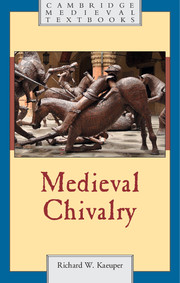Book contents
- Frontmatter
- Dedication
- Contents
- List of figures
- Acknowledgments
- Part I An approach to chivalry: was it real and practical?
- Part II Three broad chronological phases
- 3 Phase one: knighthood becoming chivalry
- 4 Phase two: knighthood and chivalry fuse
- 5 Phase three: chivalry beyond formal knighthood
- Part III The privileged practice of violence
- Part IV Chivalry, governing institutions, and ideals
- Part V The world of chivalric emotions
- Reflections
- Select Bibliography
- Index
5 - Phase three: chivalry beyond formal knighthood
from Part II - Three broad chronological phases
Published online by Cambridge University Press: 05 August 2016
- Frontmatter
- Dedication
- Contents
- List of figures
- Acknowledgments
- Part I An approach to chivalry: was it real and practical?
- Part II Three broad chronological phases
- 3 Phase one: knighthood becoming chivalry
- 4 Phase two: knighthood and chivalry fuse
- 5 Phase three: chivalry beyond formal knighthood
- Part III The privileged practice of violence
- Part IV Chivalry, governing institutions, and ideals
- Part V The world of chivalric emotions
- Reflections
- Select Bibliography
- Index
Summary
Chivalry did not suddenly wither and die in the final, traditional medieval centuries. Strenuous combat involving knights in full battle armor could be attested by the classic account of Philippe de Commynes (d. 1511). It could be even more personally attested by the Burgundian lord Louis de la Tremoille in 1525, if we could interview him before the fatal shot on the battlefield of Pavia ended his intensely chivalric life, at that point devoted to the ill-fated French campaign in northern Italy. He died in a full suit of armor and with a full sense of religious no less than royal blessing upon his life's work.
The ideas and ideals of chivalry so evident in Louis's life still permeated the general cultural atmosphere. Christine de Pizan wrote a much-appreciated work, The Book of Deeds of Arms and of Chivalry, in the vernacular in the early fifteenth century. Romances, likely reaching an even broader audience than ever, blossomed in such late – and very large – blooms as Matteo Maria Boiardo's Orlando Innamorato (1495), Ludovico Ariosto's Orlando Furioso (1532), and Edmund Spenser's Faerie Queene (1590, 1596). Formal dubbing to knighthood lasted throughout the fourteenth and fifteenth centuries and beyond, as could be attested by witnesses who stood on the crowded deck of the Golden Hind when a kneeling Francis Drake was knighted by Queen Elizabeth I in 1581.
Yet during its final phase – as was true in earlier phases – if important elements of chivalry persisted, significant changes affected the fit of chivalry within its changing social context. That these centuries could generate changes in chivalry can come as no surprise. The age experienced seemingly endless war funded by effective systems of taxation; these conflicts occurred during a time of economic and demographic contraction. Royal power underwent severe modulations, and even when it was doing well faced problems of public order that persisted and seemed beyond its control, if not a by-product of its actions; beyond any scale of human agency, terrifying and destructive plague ravaged Europe. On the brighter side, new intellectual currents swirled around thinkers as winds of neoclassicism swept through the quiet nooks where scholars and writers pondered issues of sovereignty, war and peace, theology, and canon and civil law, and wrote both learned and more popular treatises, often with clear messages for the chivalrous.
- Type
- Chapter
- Information
- Medieval Chivalry , pp. 121 - 154Publisher: Cambridge University PressPrint publication year: 2016



